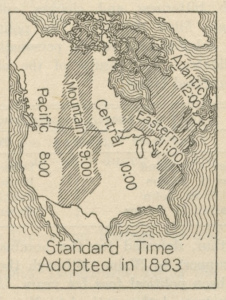Whether your 10 year old likes trains or time zones are part of a lesson at school, consider the many systems and sciences that came together to influence the standard time we use today. Can you name them? We don’t give it much thought these days but standard times are a fairly recent change. With the dawn of the industrial age, came the iron horse, steam trains. With mass transportation, keeping track of when your ride should arrive became very important. We are aware of that part for sure whether we’re rushing off to work or school by bus or subway. We have maps now that show the routes and schedules of some very complex transit systems. I’m thankful for such good maps for London or I’d still be roaming the streets looking for an entrance to the tube. (Not an entirely bad thing.) It’s obviously very important to us in our daily life but how did trains influence world time?
The British were, in fact, the first to use a standard time for their rail systems. Back in 1764 (some sites say 1761), John Harrison found that clocks could give accurate information as to a ship’s location. That gave way to marine chronometers and a new Longitude Act in 1765. The Royal Observatory, Greenwich in London has influences in navigation, astronomy, and in becoming the first to use the Greenwich Mean Time for its rail systems. Beginning in 1840 with one railway adopting the standard time, it took 7 years for most of the other railways to follow suit. It took the legal system til 1880 to switch to the standard time, however. It was only 4 years later that the Greenwich Mean Time was voted by 22 countries as the Prime Meridian.
You can guess that trains were the biggest influence in the migration of people westward in the US. As trains went further, it became evident that time was different for different areas. If your pocket watch was set to Virginia time, you had to reset it when you arrived in Texas. Even between towns in the same state, like Houston and Austin, the times were different. It was suggested in 1808 to Congress by William Lambert, but was ignored, as was Charles Dowd’s proposal, until 1883. Though the railways followed the standard time, many individuals and towns did not rely on it for their local activities. As the map at the right shows, there were still adjustments that were made. It was many years later, in 1918, when standard time zones were enacted into US law.
Many people and many years were involved in making the time zones we are so familiar with today. Did you see the sciences involved? Geography, astronomy, horology, marine navigation, steam technology. But we don’t use trains as much for travel, at least not in Texas. My boys and I still get excited, though, to see the diesels trains come roar through our small town. There’s still a lot kids can learn from trains. My next blog will supply some more ideas for the younger kids so stay tuned!







Get Social!